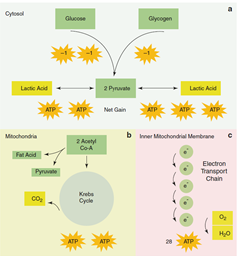17.2.1: Short-Term Energy- Glycolytic Pathway
- Page ID
- 39168
The Glycolytic System fuels Short-Term Energy demands
After the immediate source of cell energy, including that used for muscle contraction (ATP and PCr) have reached exhaustion, the next more complex process begins to take action within the cytosol. The glycolytic pathway breaks down carbohydrate storage forms of glycogen and glucose.1
In a series of 10-12 enzymatic reactions, glucose is broken down in the process called glycolysis to produce two molecules of pyruvate and four molecules of ATP. However, as mentioned earlier, the initial process is ATP-dependent and requires two molecules of ATP to 'jump-start' the breakdown of glucose. Hence, the net generation of ATP during the initial glycolysis step is (-2) + 4 = two molecules of ATP.2
Glossary Term: Glycolysis - Breakdown of glucose; for each molecule of glucose, two molecules of pyruvate and two ATP molecules are produced.
Glycolysis ( g l y c o = glucose , l y s i s = break apart ) is the universal pathway for glucose oxidation, whereby glucose metabolism is an essential energy source for all cells and particularly the brain and red blood cells, as well as skeletal muscles.3
In contrast, if glycogen is broken down to pyruvate during glycogenolysis, only one ATP molecule is consumed, and therefore glycogenolysis allows for a higher ATP harvest as three ATP molecules are generated.1 In both cases, the amount of energy produced is relatively small, and the available capacity of this system is ~1 min (see figure 9.2.2.1). In the absence of adequate oxygen (e.g, during a 100-yard sprint), pyruvate (a.k.a. pyruvic acid) is then converted to lactic acid; the detailed transition reaction is described in segment 9.3.5.

Figure 9.2.2.1 The production of ATP starts during glycolysis or glycogenolysis with the formation of pyruvate (a), which is further broken down into acetyl coenzyme A (which may also be used to form a fatty acid or pyruvate) to enter the Krebs cycle (b). The hydrogen ions released in this reaction are carried to the electron transport chain where a large amount of ATP is formed (c).[Adopted and modified from 1]
The glycolytic pathway is regulated by negative feedback; meaning, it is upregulated by high concentrations of ADP and Pi whereas it is downregulated by high concentrations of ATP.2
For more detail on glycolysis and glycogenolysis, please refer to sections 9.3.3. and 9.3.4.
Although the amount of ATP produced during glycolysis and glycogenolysis is relatively scarce, the combined actions of both the ATP-PCr and glycolytic systems allow the skeletal muscles to generate force when oxygen availability is low.
If sufficient oxygen is available to the muscle cell during glycolysis, the oxidative system begins to assume the majority of energy production.1
Check your knowledge:
True or False: The net energy gain from glycolysis is 2 molecules of ATP.
Contributors
References & Links
- Sousa, A., Ribeiro, J. & Figueiredo, P. (2019). Physiological Demands in Sports Practice. 10.1007/978-3-030-10433-7_4.
- Gropper SS, Smith JL, Groff JL. (2016) Advanced nutrition and human metabolism (7th ed.). Cengage.
- Blake, J. S., Munoz, K. D., & Volpe, S. (2019). Nutrition: From Science to You (4th ed.). Pearson.

